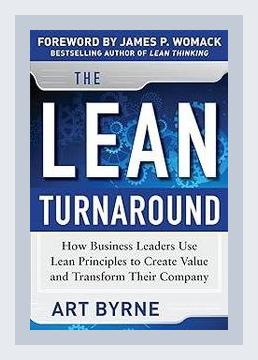Operations and Supply Chain ManagementProcess Improvement
**
Art Byrne’s “The Lean Turnaround” is a compelling guide to transforming organizations using Lean principles. With his extensive experience in turning around various companies, Byrne elucidates how businesses can not only survive but thrive by adhering to Lean philosophies. This summary reflects the core principles, examples, and actionable steps presented in the book.
1. Introduction to Lean
Major Points:
- Definition of Lean: At its heart, Lean is about delivering customer value efficiently by minimizing waste.
- Historical Roots: Originated in Toyota Production System (TPS), Lean’s key principles include continuous improvement (Kaizen) and respect for people.
Action Step:
– Educate Teams: Begin with educating your workforce about Lean principles and its benefits. Use case studies from companies like Toyota to illustrate these points.
Example:
– Toyota’s systematic elimination of waste and focus on value creation are illustrated as benchmarks.
2. The Lean Turnaround Mindset
Major Points:
- Leadership Commitment: Success with Lean starts from the top. Leaders must be fully committed.
- Long-term Perspective: Lean transformations are not quick fixes but long-term commitments.
Action Step:
– Lead by Example: As a leader, demonstrate commitment by actively engaging in Lean projects and learning.
Example:
– Byrne’s own leadership at Wiremold, where his visible commitment to Lean principles catalyzed a successful transformation.
3. Identifying Waste
Major Points:
- Types of Waste: Identify the seven types of waste (overproduction, waiting, transport, extra processing, inventory, motion, and defects).
- Value Stream Mapping: Use this tool to visualize processes and identify areas of waste.
Action Step:
– Conduct a Waste Audit: Regularly assess processes to identify and eliminate waste using value stream mapping techniques.
Example:
– At Wiremold, identifying transport and motion waste led to simpler, more efficient workflows.
4. Lean Tools and Techniques
Major Points:
- 5S Methodology: Sort, Set in order, Shine, Standardize, and Sustain.
- Just-In-Time (JIT): Produce only what is needed, when it is needed.
- Kanban: Visual cues to manage workflow more efficiently.
- Poka-Yoke: Implementing mistake-proofing devices to reduce errors.
Action Step:
– Implement 5S: Start with the 5S methodology within your workplace to create an organized, efficient environment.
Example:
– Wiremold’s adoption of 5S resulted in a cleaner, more organized workspace, boosting productivity.
5. Employee Empowerment
Major Points:
- Involve Everyone: Every employee should be engaged in the Lean journey.
- Continuous Improvement Culture: Foster a culture where employees are encouraged to suggest and implement improvements.
Action Step:
– Engage Employees: Set up regular Kaizen events and involve employees at all levels in problem-solving activities.
Example:
– At Wiremold, Byrne empowered employees to suggest improvements which led to numerous small but impactful changes.
6. Lean Financial Management
Major Points:
- Lean Accounting: Traditional accounting can obscure true performance; Lean accounting aligns financial practices with Lean principles.
- Value-Centric Metrics: Focus on metrics that reflect true value creation rather than merely cost reduction.
Action Step:
– Adopt Lean Metrics: Transition to metrics that emphasize value creation, such as lead time, throughput, and first-time quality.
Example:
– Byrne’s approach at Wiremold included critical metrics like reduction in lead times, which directly reflected operational improvements.
7. Implementing Lean in Service Industries
Major Points:
- Lean Beyond Manufacturing: Lean isn’t limited to manufacturing; it can optimize processes in service sectors as well.
- Office Kaizen: Apply Lean tools to office and administrative processes to enhance efficiency.
Action Step:
– Pilot Lean Initiatives in Services: Choose a service process and use Lean tools to identify and reduce waste.
Example:
– Byrne illustrates Lean applications in healthcare, reducing patient wait times and improving service delivery at hospitals.
8. Sustaining Lean Transformation
Major Points:
- Prevent Backsliding: Ensure continuous improvement becomes a part of organizational culture.
- Ongoing Training: Continuous Lean education for employees at all levels.
Action Step:
– Establish Continuous Improvement Teams: Create teams dedicated to sustaining and expanding Lean initiatives.
Example:
– Wiremold’s structured approach to maintaining its Lean achievements through continuous training and Kaizen events.
9. The Role of Executives
Major Points:
- Active Involvement: Executives must not only support but actively participate in Lean transformation.
- Role Modeling: Executives should embody Lean principles in their behavior and decisions.
Action Step:
– Gemba Walks: Regularly conduct Gemba walks to observe operations firsthand and engage with employees.
Example:
– Byrne practiced Gemba walks at Wiremold to stay connected with actual operational challenges and opportunities.
10. Challenges and Solutions
Major Points:
- Common Pitfalls: Resistance to change, misunderstanding of Lean principles, and lack of sustained commitment.
- Overcoming Resistance: Through clear communication, training, and aligning Lean efforts with strategic goals.
Action Step:
– Clear Communication: Regularly communicate the vision, progress, and successes of Lean initiatives to all stakeholders.
Example:
– Overcoming initial resistance at Wiremold involved transparent communication about the goals and benefits of Lean transformation.
Conclusion
Summary:
Byrne’s “The Lean Turnaround” provides a comprehensive roadmap for any leader looking to transform their organization using Lean principles. It emphasizes the importance of leadership, employee involvement, proper tools, and a long-term commitment to continuous improvement. Real-life examples from Byrne’s career illustrate the tangible benefits of Lean transformation.
Final Action Step:
– Commitment: Commit to the Lean journey with a clear, long-term vision and engage every level of the organization in the process.
By implementing these strategies, businesses can achieve remarkable enhancements in efficiency, customer satisfaction, and overall value creation.
This summary delivers a structured and in-depth insight into “The Lean Turnaround,” focusing on practical steps and real-world examples that reflect Byrne’s expertise and successful application of Lean principles.
